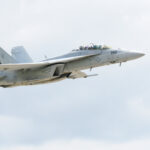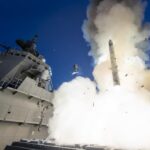New R&E Roles. Under Secretary of Defense for Research and Engineering Heidi Shyu told reporters last week she is considering establishing two new positions in her organization, a director of processing and software and a director of sustainment technologies. Shyu said the former will be tasked with leading her effort to drive down the Pentagon’s sustainment costs for weapon systems while the latter will lead one of her technology priorities to bolster the department’s “trusted software” capabilities. “There are several key positions I’ll be creating that are new, that don’t exist yet. We’re actually in the process of getting the new org chart revamped and we’re focused on the key strategic thrust areas that I’m focused on. And then I need to get together with the deputy secretary of defense to show what my strategy is moving forward and get her blessing. Hopefully it will be done very soon,” Shyu said during an Oct.12 press briefing at the annual AUSA conference.
KC-46 Additions. In the coming months, the U.S. Air Force’s Air Mobility Command (AMC) expects the Boeing KC-46 tanker to receive limited certifications and operational test clearances to allow it to refuel the CV-22 and MV-22 tiltrotors and the B-2A stealth bomber. The KC-46 is certified to refuel F/A-18s and the EA-18G with no restrictions. With varying restrictions the KC-46 is certified to conduct boom refueling of other KC-46s, the F-35A, the F-22, the B-1B and B-52H bombers, the C-17A transport, F-15s and F-16s, the HC/MC/AC-130J, the KC-10, the E-3G Airborne Warning and Control System, the C-5M, and the RT/TC-135s. A redesign of the KC-46’s stiff boom will mean the KC-46 is unlikely to be able to refuel the A-10 until fiscal 2023.
…Lightening the Load. Air Force Gen. Mike Minihan, the commander of AMC, approved a third Interim Capability Release (ICR) for the KC-46 on Oct. 13—a release that allows the KC-46 to refuel all variants of the F-15 and F-16 during U.S. Transportation Command (TRANSCOM)-tasked missions, AMC said. The move is to free up KC-135s and KC-10s to focus on forward deployed refueling missions, rather than training ones. Air Force Brig. Gen. Ryan Samuelson, AMC deputy director of strategy, plans, requirements and programs and KC-46 cross functional team lead, said in a statement that the KC-46 “can now support 62 percent of all receiver aircraft that request air refueling support from TRANSCOM.” On July 9, AMC approved the first ICR to allow the KC-46 to refuel aircraft using the KC-46’s centerline drogue system, while AMC approved the second ICR on Aug. 5 to permit the KC-46 to refuel the B-52, C-17 and other KC-46s using the boom. AMC said that “despite existing restrictions and deficiencies, the KC-46 continues to demonstrate its growing operational capabilities” and that it has completed “over 6,000 missions, offloading over 35 million pounds of fuel, and making 26,000 boom and 1,500 drogue contacts since January 2019.”
CH-53K International. Lockheed Martin’s Sikorsky President Paul Lemmo told reporters this week that after Israel, the company is waiting to see if Germany will purchase the CH-53K King Stallion helicopter. The company is competing against Boeing’s Chinook for a German competition to procure 40-45 helicopters. Lemmo said the company is waiting to see how the new government develops in Germany and is hopeful for a decision in 2022. He also said three other countries are actively talking to the company about procuring the helicopter, but would not disclose them. However, Lemmo said while the U.S. Marine Corps has 200 CH-53Ks in the program of record, the company is planning to sell at least another 100, and so expects a 300 total aircraft build between U.S. and international customers. Lemmo spoke to reporters during the annual AUSA conference.
…Digital Focus. Lemmo also noted the company’s experience with helicopter digital models and design. He said a CH-53K King Stallion helicopter design problem that involved re-ingestion of exhaust was solved faster than it would have been earlier due to the digital physics-based models. In flight tests the Marine Corps found these design deficiencies that delayed operational testing and entry into service. The Navy said the problem had been fixed by December 2019. “Because we had a physics-based physical model of the aircraft, we were able to solve that problem in six months. That may sound long, but if we did it with traditional methods it would have been a couple of years.” Lemmo added since the company models were accurate, they did not have to fly the aircraft tens of times to find the right solution. “Our models were accurate, we were able to go through several design iterations and come up with a solution, then we flight tested that and it performed exactly as the model said.”
FMS Chief to Boeing. Heidi Grant, who as director of the Defense Department’s Security Cooperation Agency oversees the Pentagon’s foreign military sales programs, will be departing government shortly to work at Boeing as vice president of business development for the company’s defense and global services segments. Grant’s last official day at DSCA is Nov. 6 and she begins at Boeing on Nov. 8. Grant succeeds Jeff Shockey, who left Boeing in July. She will report to Leanne Caret, Boeing’s defense chief, and Ted Colbert, who leads the services segment. Appointed director of DSCA on Aug. 2020., Grant oversees more than 15,000 FMS cases valued at $620 billion in over 150 countries. Before joining DSCA, she was director of the Defense Technology Security Administration, which develops and implements DoD technology security policies on international arms and services transfers.
Katalyst Architecture. General Dynamics Land Systems showcased its new Katalyst next-generation electronic vehicle architecture at last week’s AUSA conference, which the company said will be a key component for its Optionally Manned Fighting Vehicle offering and other future combat vehicle work. Katalyst was integrated on a medium-weight tracked vehicle demonstrator at the show. “Essentially, what Katalyst is for us is the mechanism with which you can bring in new capabilities and use it on the vehicle. And the purpose of the architecture is to do things like sensor fusion. You take the feed from a UAV or a ground robot and you can bring it into the vision of the soldiers there or shared around the formation. You can include the 360-degree view around the vehicle itself and share that with soldiers that are in the back of the vehicle so they can see through armor and see what’s going on outside,” Bob Lennox, GDLS’ vice president of strategy and growth told Defense Daily, noting the capability’s focus on ensuring maximized modularity for future combat vehicle programs.
Thales OMFV Study. The Army last month tapped Thales USA to work on a 12-month trade study focused on integrating wireless Ethernet capabilities on the service’s future Optionally Manned Fighting Vehicle (OMFV) platform. The trade study is intended to help the Army refine requirements for a potential OMFV wireless ethernet subsystem. “This is an effort that is just kicking off with the government. As you look at the new platforms and the sensor capability, the backbone of that vehicle really has to modernize and process a tremendous amount of data quickly and get it to the right people, both in that vehicle and then deployed across the force,” Eric Balascik, Thales USA’s director of business development for sensors and missile systems told reporters in a briefing. “Ultimately, [the trade study] will help inform the Army requirements for Phase 3 of OMFV and help them make a decision on how they will procure that type of system.”
…Thales Radios. Thales also announced on Oct. 12 the company has received its first production order from the Army to deliver its AN/PRC-170 Javelin Radio. The order for the small form factor, Mobile Ad-Hoc Networking (MANET)-capable radios was placed under the Single Channel TSM Radio program as part of the Army’s integrated tactical network (ITN) modernization initiatives. “The introduction of the AN/PRC-170 Javelin radio continues the Thales tradition of being responsive to emerging Warfighter needs. In the hands of U.S. soldiers since February 2020, the Javelin radio embraces the [non-developmental] approach to delivering capabilities into the Army ITN architecture, and ensures voice and data networking connectivity to the tactical edge. Designed with soldier systems in mind, Javelin is easily integrated into the Army’s ITN and can be leveraged to support the Army’s emerging Integrated Visual Augmentation Systems architecture,” Mike Sheehan, CEO of Thales Defense & Security Inc., said in a statement.
L3Harris Radios. L3Harris Technologies announced on Oct. 11 it has received its first order from the Army to deliver 1,000 of its new Falcon IV AN/PRC-171 Compact Team Radios. “The delivery of these single-channel radios furthers L3Harris’ support of the U.S. Army’s new Integrated Tactical Network by enabling all tactical operators to share situational awareness information across the entire network,” Bryant Henson, L3Harris’ president of tactical communication, said in a statement. “These radios will field alongside our HMS Manpack and Leader Radios at the squad level—extending the network and warfighter effectiveness to all soldiers.” L3Harris said the Compact Team Radio provides more than 20 hours of continuous voice and data communication on a single battery and is designed to operate with systems such as the new Enhanced Night Vision—Binocular the company is also delivering to the Army.
LCS-32. The Navy planned to christen the latest Independence-variant littoral combat ship (LCS), the future USS Santa Barbara (LCS-32) at a ceremony on Oct. 16 in Mobile, Ala. Meredith Berger, performing the duties of Under Secretary of the Navy, was scheduled to deliver the keynote address at the event. The ship was built by Austal USA as the 16th Independence-variant LCS and 32nd overall.
Cyber Warning. The U.S. government is warning of ongoing malicious cyber activity against U.S. water and wastewater systems, including the Defense Department’s domestic and global facilities, by known and unknown actors targeting information and operational technology networks. An Oct. 14 Cybersecurity Advisory issued by the FBI, Cybersecurity and Infrastructure Security Agency, the Environmental Protection Agency, and National Security Agency, warns that attackers are using spearphishing, exploiting outdated or unsupported operating systems and software, and control system devices with vulnerable firmware versions. The advisory doesn’t attribute the malign activity to specific actors.
Place to Connect Dots. The recent standup within the Cybersecurity and Infrastructure Security Agency of a joint center that brings together government and private sector partners together their respective insights and information around cyber and ransomware attacks will help inform and connect “dots” to strengthen the nation’s cybersecurity posture, says National Cyber Director Chris Inglis. The Joint Cyber Defense Collaborative “is a place where we can gather private sector, public sector, multiple authorities, multiple perspectives to try to figure out, how do we collaborate such that we can make it such that if you’re going to beat one of us in cyberspace, you’re going to beat all of us in cyberspace,” he says at CISA’s cyber summit.













